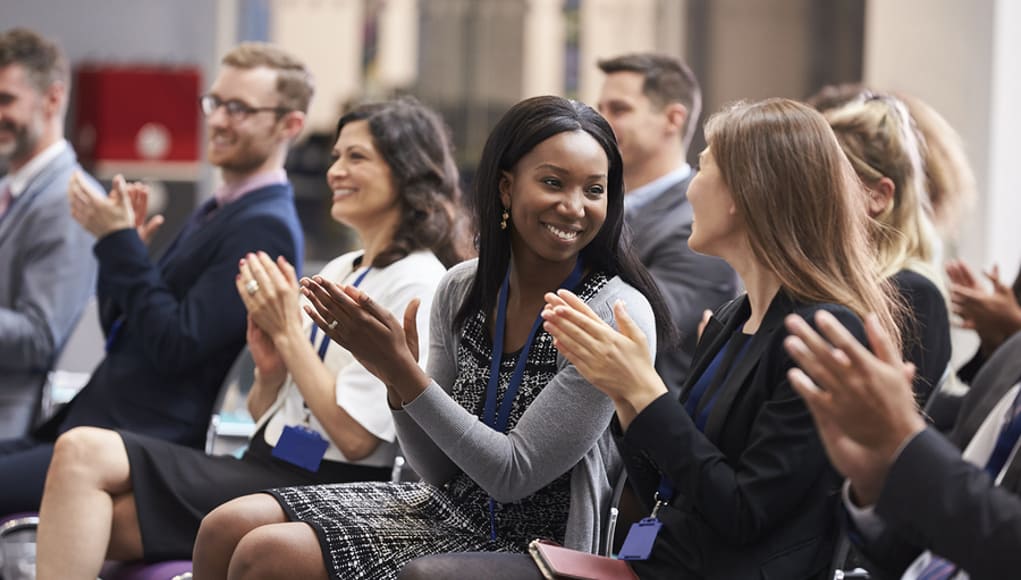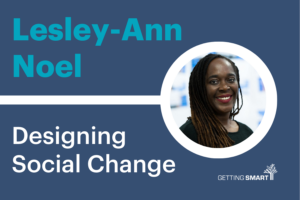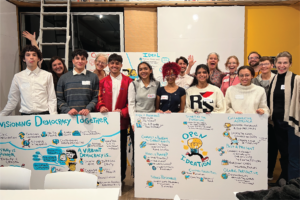Designing Professional Learning Experiences: 3 Lessons from BPLC18

By Cathy Sanford.
By 4:30 pm on Saturday, April 7, Adrianne had been actively engaged in professional learning activities for the past fifty-six hours as a participant in the 2018 Blended and Personalized Learning conference. She was definitely tired but had a beer in her hand and a huge smile on her face. “This conference was fantastic,” she reflected. “I wish all of my professional development opportunities could be like this. This conference is what educators need to stay inspired after 15+ years.”
As she prepared to depart for the airport, I pressed the veteran elementary teacher for details on what had inspired her over the course of her conference experience. Her response was enlightening. “This is a pretty big event,” she began, referencing the 1,200 educators and leaders who had taken part in various BPLC18 activities over three days in Providence, RI, “but it still felt really authentic. I was always able to find something that resonated with my current experience, and everything was anchored in student and teacher voice.”
Adrianne’s words echoed in my mind as our conference team pored over participant and presenter feedback and found many similar sentiments. Hosted by the Highlander Institute and The Learning Accelerator, the annual spring Blended & Personalized Learning Conference holds a unique place in the education conference landscape. In addition to being excited about tools or strategies they had come across during the event, many participants shared specific conference design features that they intend to bring back to their teams, schools, and districts when running professional learning opportunities. Here are the three key components that participants found most compelling:
1. Showcase current practitioners
At most conferences––and in many smaller professional learning sessions––educators learn from consultants or experts with little direct connection to current classrooms, schools or districts. At the BPLC, both leadership sessions and instructional sessions are led by current practitioner experts with a focus on sharing specific tactics. Participants expressed gratitude for the knowledgeable and accessible session leaders who came from classrooms, schools and districts across the country. Presenters were eager to share resources and approaches behind their success stories while being thoughtful about challenges and pitfalls to avoid. “It is inspiring and motivating to hear directly from teachers,” reflected a high school department head. “I am more likely to try something new when a teacher is sharing the information.”
In addition to practitioner-led sessions at BPLC18, participants learned through school site visits and classroom simulations. Both opportunities allowed participants to hear directly from students, early adopter teachers, and principals, who shared their perspectives on new teaching shifts. “It makes a huge difference to hear from fellow educators,” agreed a principal. “They are grounded in reality and understand the challenges we face. It made me realize that my faculty would benefit from learning from their colleagues rather than outside experts on PD days.”
2. Model a personalized learning experience
Over time, the BPLC event has expanded from a focus on keynote presentations and workshops to a multifaceted program of activities to support the strengths, needs and preferred learning styles of diverse participants. Pathways through the three day event included site visits to Rhode Island schools; a leadership strand, advanced conversations for experienced practitioners; a practice playground offering a collaborative, playlist approach to learning; a Learn-It Lounge offering 1:1 consultation and coaching; a shark-tank style competition; a technology playground; and a rapid-fire “smackdown” open sharing format. Some participants spent most of the Saturday Symposium in the Learn-It Lounge planning with colleagues and a practitioner expert. Others preferred to take advantage of the session offerings. Participants who ventured outside of a normal conference routine to explore different activities appreciated the chance to learn at their own level.
“It was great to have the opportunity to sit quietly with a current district expert in the Learn-It Lounge and get some personalized coaching,” remarked an administrator who was determined to re-create the Lounge concept during her district professional development days.
A school leader appreciated the leveled conversations, stating “The Advanced Practitioner Summit really fed my educator soul and left me wanting more!”
“The experiences I chose were really personalized to my level of knowledge and comfort level,” reflected a teacher. “And I feel like the most valuable thing I’m bringing back to my school are ideas for offering more personalized professional learning.”
3. Focus on building networks
Often, information is presented at conference workshops using a stand-and-deliver format. At BPLC, the focus is on collaboration, dialogue and tactical planning. From consultancies focused on a problem of practice to roundtable discussions on lessons learned to sessions centered on redesign, participants were encouraged to leverage the experiences of everyone in the room. Sharing stories was a central theme and enabled participants to forge relationships with others engaged in similar initiatives or addressing similar obstacles.
“This was an inspiring and informative conference with an agenda that allowed for relationship cultivation,” shared a teacher. “I feel like I am leaving with a network of people that are willing to help me and provide feedback as I start to implement blended learning in my classroom.”
“I think the most memorable moment of the conference was being able to talk with other teachers from around the state and country and hear what is and is not working within their classroom,” reflected another teacher.
Many participants enjoyed hearing from students during the conference as well. Student voice was an important component of school site visits, classroom simulations, the technology playground and the opening remarks at the Saturday Symposium. “The students I met were the most valuable part of the conference for me,” remarked a principal. “They were articulate, passionate and inspiring. Hearing their perspectives and voices was eye-opening and inspired me to consider how to infuse student voice into more of our leadership conversations.”
As you contemplate how to add value to professional learning activities in your own realm, consider the lessons we have learned from designing (and redesigning) the Blended & Personalized Learning Conference each year. Better yet, join us for BPLC19 from April 4-6 in Providence, RI!
The BPLC19 conference team is accepting session proposals from current classroom, school and district leaders from now until September 15th. For details, go to http://blendedlearningconference.com/presenter-rfp. Participant registration opens on October 1st.
Cathy Sanford leads research and development efforts at the Highlander Institute in Providence, RI. She is also the author of Pathways to Personalization: A Framework for School Change. Share your thoughts and insights with Cathy by tweeting @csanford42.
For more, see:
- Takeaways from the 2017 Blended and Personalized Learning Conference
- Deeper Learning 2018 | Powerful Adult Learning
- Learning from Leaders, Students and Educators at SXSW EDU
- 9 Ways to Make Student Work Authentic
Stay in-the-know with all things EdTech and innovations in learning by signing up to receive the weekly Smart Update.



0 Comments
Leave a Comment
Your email address will not be published. All fields are required.